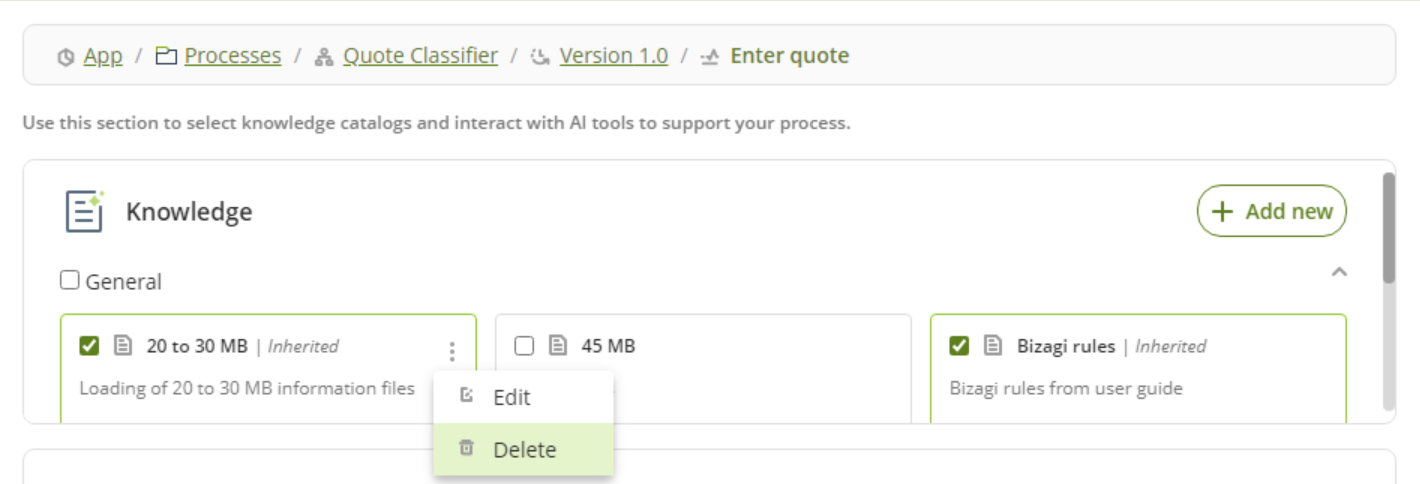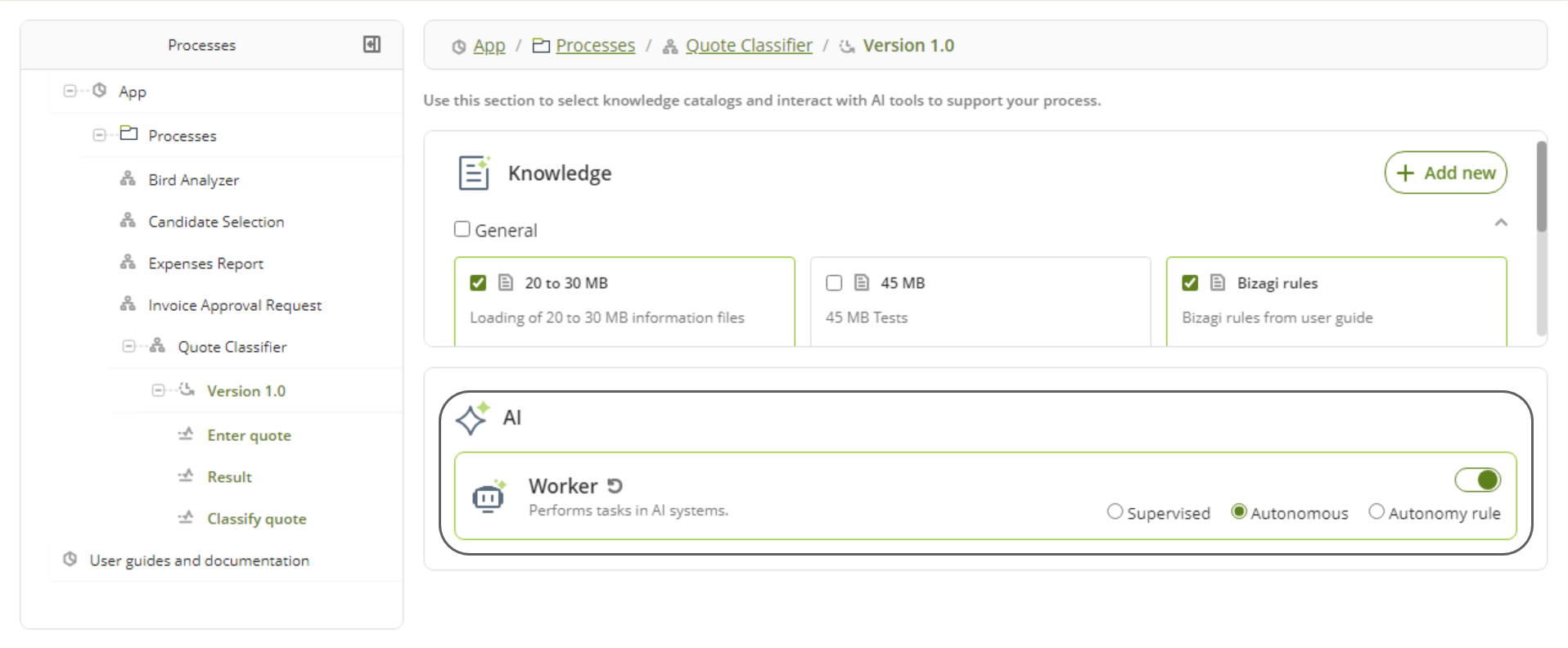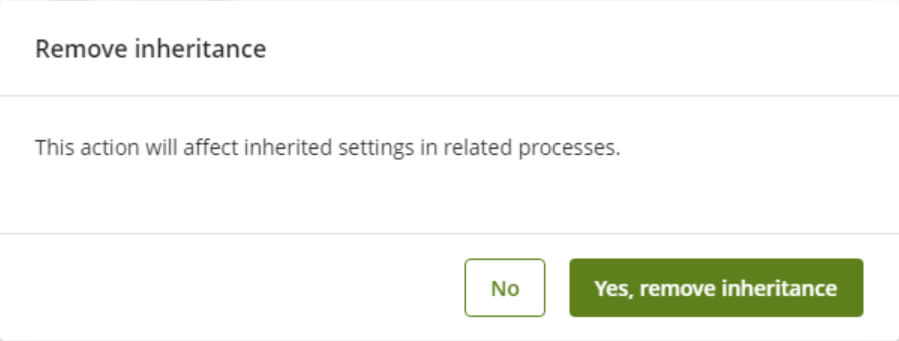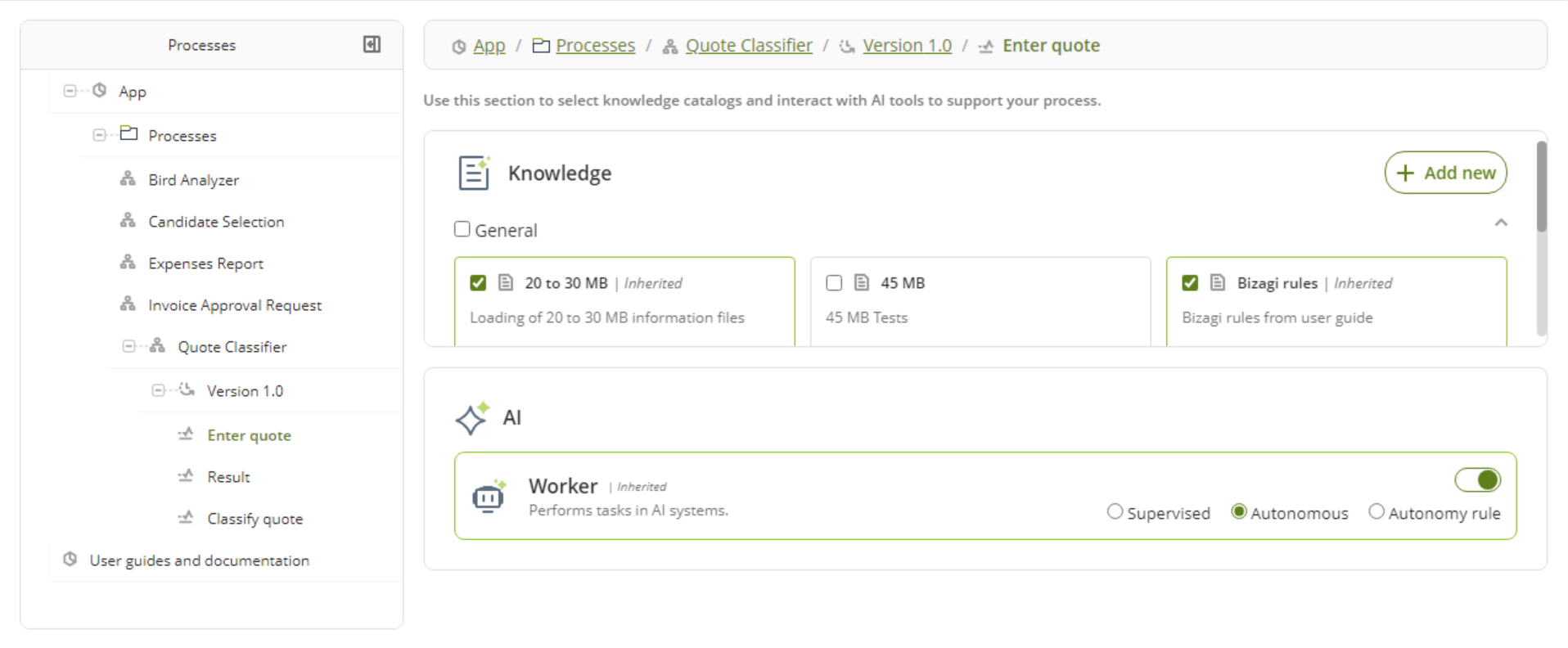Overview
The AI in Process feature in Bizagi Studio allows you to associate Knowledge Base Catalogs and AI Workers with different levels of your process tree (Application, Process, Version, or Task).
This setup lets you centralize and simplify the management of knowledge and automation across your business processes.
Inheritance rules make it possible to define configurations at higher levels and automatically apply them to lower levels, while still keeping the flexibility to override them when necessary.

Key concepts
Knowledge Base Catalogs
Knowledge Base Catalogs are structured repositories of information that an AI Agent or an AI Worker can use to provide accurate and contextual answers. They can include documents, structured data, or files, organized into categories for easier administration.
In AI in Process, you can assign Catalogs to specific nodes in the process tree:
•At the Category level: all Catalogs in the Category are applied as a group.
•At the Catalog level: you can select one or more Catalogs individually.
Once a Catalog or Category is associated with a node in the process tree, AI Agents and AI Workers will automatically take that knowledge into account during execution, without further configuration.
|
Catalogs inherited from parent nodes display the label Inherited, with a tooltip showing their origin. |
For more details about Catalogs, see Enterprise Knowledge.
AI Workers
AI Workers are intelligent agents that support process execution.
In AI in Process, you can select one mode per node:
•Supervised: The AI suggests actions, but a user confirms them.
•Autonomous: The AI acts independently without user validation.
•Autonomy Rule: The AI acts autonomously only when predefined rules are met.
|
When you select Autonomy Rule, you can either define a new rule or associate an existing one. This can be done directly in AI in Process or when configuring a Task as an AI Worker Task. |
For more details about AI Workers, see AI Workers.
Inheritance
•Configurations apply from parent to child nodes only.
•Child nodes may override inherited settings.
•There is no inheritance between sibling nodes, or from child to parent.
Navigating AI in Process
1.From the Home menu, select AI in Process.
2.The left panel displays the process tree with Applications, Processes, Versions, and Tasks.
3.When you select a node, its full path is displayed at the top (e.g., App/Processes/Quote Classifier/Version 1.0/Classify quote).
4.The right panel shows the Knowledge Base Catalogs and AI Workers associated with the selected node.

|
If no Knowledge Base Catalogs or AI Workers have been created (and none are inherited from parent nodes), the AI in Process interface will appear empty until new items are added. |
Configuring Knowledge Base Catalogs in AI in Process
1.Select a node in the process tree.
2.In the right panel, view the available Categories and Catalogs. These include items created either in the AI Hub (Expert view) or here in AI in Process.
Choose how to configure them:
•At the Category level: apply all Catalogs in that Category by checking the checkbox with the Category name (e.g., General). If you do this, individual catalogs within the category cannot be edited.

•At the Catalog level: select one or more Catalogs individually by checking the checkbox with the Catalog name.

Your selections are applied automatically.
|
Inherited Catalogs will be marked with the Inherited label.
|
You can also:
•Add a Catalog: click Add New, fill in the details, and select Create.

•Edit a Catalog: open the three-dot menu, select Edit, update the information, and save.

•Delete a Catalog: open the three-dot menu, select Delete, and confirm.


|
If a Catalog has dependencies, it cannot be deleted.
|
|
All changes sync with the AI Hub. |
Configuring AI Workers in AI in Process
1.Select a node in the process tree.
2.Enable the AI Worker configuration by clicking the toggle switch.
3.Choose one of the modes (Supervised, Autonomous, Autonomy Rule) by clicking the corresponding radio button.

|
Modes are mutually exclusive. Only one can be active per node. |
Your selection is applied automatically.
Restoring inherited configurations
If a child node overrides a configuration inherited from a parent node, you can choose to remove the inheritance.
When you attempt to do so, a confirmation message appears asking if you want to proceed:

Once inheritance is removed, the Catalogs or AI Workers at the child node can be configured independently.
If needed, you can restore the inherited settings by clicking the Reset icon in the respective Catalog or AI Worker section.

The inherited configuration will be restored automatically.

Best practices
•Configure Catalogs and AI Workers at higher nodes to ensure consistency and reduce administrative effort.
•Override configurations only when necessary, and document the reason.
Last Updated 11/18/2025 11:44:12 PM

